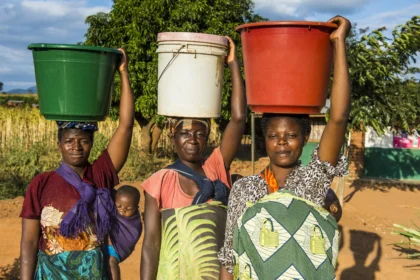Bridging the gap between old people and young people with technology

Imagine the world without technology, without smart phones and internet. How would family and friends stay connected in a distance? Technology innovation is helpful but ensuring that all generations are capable of conceptualizing it and using it is a key factor so that no one is left behind regardless of their age.
I rarely communicate with the people I left back in my remote community of Maheba in Zambia. When I left 13 years ago, it was either the community leader or only one shop around that had a mobile phone. Guess what? Now, technology has advanced so much that many people in remote areas including villages have smartphones and access to the internet. But despite this, I still feel disconnected from my roots and the people who once meant so much to me.
In the remote communities of Africa, where traditions run deep and stories are passed down through generations, the influx of modern technology has brought both opportunities and challenges. As smartphones, social media, and the internet become increasingly prevalent, the gap between the new and old generation widens, leading to a sense of disconnection and misunderstanding. Thus, it is important to delve into the impact of technological advancement on bridging the generational gap in Africa’s distant communities, exploring personal experiences, observations, and potential solutions.
Effects of technology in remote communities
One of the most significant challenges faced by African remote communities is the digital divide that separates the young and old. While the younger generation embraces technology as a tool for communication, learning, and socialization, the older generation often struggles to adapt to this new digital landscape. In many rural villages, access to reliable internet connection and devices remains limited, further expanding the existing gap between the two generations.
Growing up in Africa, I witnessed firsthand the effects of technology on my community. As a young adolescent, I embraced the opportunities that technology provided, connecting with friends and family members across the globe through social media platforms. However, the elders in my village viewed technology with skepticism and mistrust. For instance, I have tried numerous times to rely on social media platforms for staying in touch with my relatives whom I left behind, but they still prefer face-to-face interactions and traditional forms of communication.
Does technology represent culture?
I strongly believe that cultural preservation is against technological progress. One of the key dilemmas faced by African remote communities is the tension between preserving cultural traditions and embracing technological progress. While the older generation values the importance of oral storytelling, traditional music, and community gatherings, my generation is drawn to the allure of smartphones, video games, and virtual interactions. Therefore, this clash of values often leads to misunderstandings and conflicts within families and communities. My father was once isolated by his own great grandparents. He had so many responsibilities as a doctor and could not enjoy much leisure for holidays. In my culture, there is a tribal gathering every mid-year and everyone is expected to be there onsite. Unfortunately, my father told them to attend the meetings virtually but consequently, he was labeled as a disrespectful child and later denied as a tribe member.
Due to that, I now fear to try to introduce new technologies or digital tools to improve efficiency or communication in my village, there may be resistance or reluctance to adopt these changes due to a preference for familiar and established methods. But is this true? Could there be alternatives or solutions to break this wall and make it become a bridge?
One possible solution I may think of is to create intergenerational learning programs that bring together elders and youth to share their knowledge and experiences. By facilitating dialogue and mutual respect, these programs can help bridge the divide and promote a sense of new unity within the community.
How to enhance technology awareness
To put these solutions into practice, there is a need for community leaders, educators, and tech innovators to work together to design and implement initiatives that promote intergenerational communication and collaboration. For example, local schools and clubs could organize workshops where students teach elders how to use smartphones and computers, while elders share stories and wisdom with the younger generation. With this approach, I personally am convinced that we can create spaces for meaningful interactions in order for communities to harness the power of technology to strengthen familial bonds and preserve cultural heritage, hence minimizing misunderstandings and conflicts between these two generations.
The reluctance of the older generation to embrace digital tools and the resistance to change pose significant challenges. Old people must rather cultivate a keen interest in technology, instead of refraining from it because the truth is the world is becoming even more digital and lack of technology knowhow will definitely be a great barrier in the future. As I reflect on my own journey of disconnection and longing for the familiar faces of my village, I am reminded of the profound impact that technological advancement has had on our lives.
By acknowledging the importance of preserving cultural traditions while embracing technological progress, we can create a harmonious balance that fosters connection and understanding between the old and the young. Through personal experiences, observations, and proactive solutions, we can pave the way for a more inclusive and interconnected future for all generations in Africa. Time isn’t supposed to stand still for our elders, while we have been thrust into a fast-paced world that they can’t even begin to understand.
(The German translation of this article can be found here./ Die deutsche Übersetzung des Artikels gibt es hier.)

